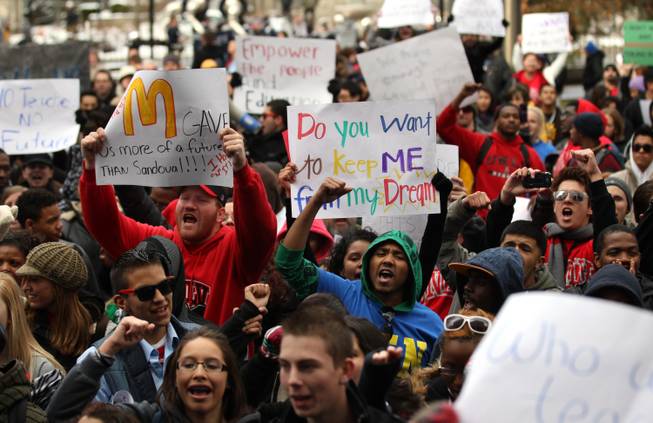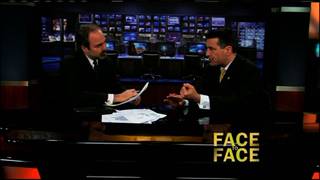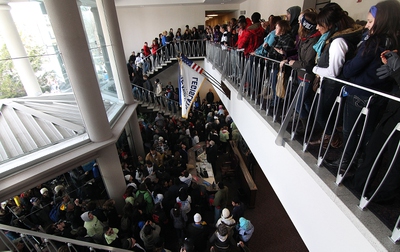
AP Photo/Cathleen Allison
Hundreds of college students swarmed the Legislature in Carson City on Monday, March 21, 2011, during a rally protesting proposed budget cuts to higher education.
Tuesday, March 22, 2011 | 2 a.m.
Reader poll
Sandoval on 'Face to Face'

Viewing video requires the latest version of Adobe's Flash Player
Sun Archives
- Students rally against budget cuts, call for business tax hike (3-21-11)
- Students plan budget cut rally after overnight bus trip to Carson City (3-20-11)
- UNLV president presents cuts, says they are “a tragic loss and a giant step backward for Nevada” (3-8-2011)
- UNLV president’s somber warning on budget cuts moves faculty to tears (2-16-2011)
- Regent says it’s time that K-12 shares in budget sacrifice (2-8-2011)
- Higher education officials say Sandoval budget cuts a ‘death sentence’ (2-4-2011)
- Education in forefront of upcoming budget battle (1-30-2011)
- Chancellor: University tuition would have to go up 73 percent to cover Sandoval budget gap (1-27-2011)
- A steep climb for Nevadans (1-26-2011)
- Soft words during State of the State hide Nevada in pain (1-25-2011)
Sun Coverage
In one of the largest demonstrations in Carson City’s memory, college students Monday spoke passionately against proposed cuts and clogged hallways, asked questions of Gov. Brian Sandoval and were told how much they mattered.
But by day’s end did they make a difference in the shape of the budget and legislation? Or were they just being paid lip service?
Students had entered the “Carson City bubble,” a place where a few hundred people in suits — lawmakers, lobbyists, staff and media — influence the outcome, and the final budget is crafted behind closed doors by about a dozen lawmakers and high-powered lobbyists.
Influence is measured in $10,000 campaign contribution checks, walkers you can mobilize at election time or political scalps collected of those who made you unhappy.
Lobbyists — notorious cynics, and the ones who don’t want to part with their power — say it’s naive to think citizens will affect the outcome. Young people don’t vote. The same legislative leadership and politically powerful interest groups will go behind closed doors and make the decisions based on personal values or crass political calculations.
Privately, many legislators, with political futures to worry about, roll their eyes at long lines of average citizens wanting to testify to committees.
To have a lasting effect, both cynics and optimists say, Monday’s rally has to be part of a bigger effort.
“What they’re trying to do doesn’t end with this demonstration,” said Guy Rocha, a state historian and supporter of the rally against cuts. “This doesn’t get them their outcome ... To have clout isn’t to be noisy — it’s to make people uncomfortable about their political future.”
He compared it with a barking dog. They’re good at getting some attention, at least in the short term. “It’s the dog’s ability to bite, to have teeth,” Rocha said. “You have to have ability to affect these people’s political lives or they will ignore you. They will pay you lip service and ignore you.”
Organizers say Monday’s demonstration was part of a broader effort. Democrats have been holding town hall meetings throughout the state. The coalition of students came from rural Nevada, north and south.
“We’ve never tried a mass mobilization of students in Nevada before,” said Erin Neff, executive director of Progress Now Nevada, a liberal group that helped organize the rally. “If they’re going to ignore them, they’re going to have to do it to their faces.”
Neff, a former journalist who covered the Legislature, knows that chanting and shouting aren’t enough. She said students will target lawmakers who are potential swing votes, such as Sen. John Lee, D-North Las Vegas — who has expressed doubts about a tax increase — and perceived Republican moderates such as Sen. Michael Roberson of Las Vegas.
Monday’s demonstration did not appear to make either one ready to pledge allegiance to raising taxes.
Lee said he’s working to find more money for the College of Southern Nevada within Sandoval’s proposed spending. Asked about raising taxes, he said, “I need another month ... We have to use what dollars are available right now. We need to figure out how doggone deep we are.”
Roberson, who got hundreds of text messages from students on his cellphone, said he wants more money to be spent in classrooms instead of administration, but said there would be cuts. “I support their right to do what they need to do,” he said of the students. “But protests will not influence my vote one way or the other.”
Some rally leaders expressed political savvy.
“We need to provide political cover to lawmakers,” said Kyle George, chairman of the Nevada Student Alliance. “We have to tell them that we are the people who got them elected.”
Senate Majority Leader Steven Horsford, D-North Las Vegas, said the sheer number of people in Carson City can’t be discounted. They and their families are voters.
“Lawmakers will ignore their constituents who say we have to preserve education at their own peril,” he said. “This budget will not pass gutting education the way it does.”
But then there are the cynics.
A couple of smartly dressed lobbyists outside the Legislature on Monday morning observed the demonstrators. A reporter approached, and offered them anonymity to assess the situation frankly.
Do the demonstrations matter? Lobbyist No. 1 rolled his eyes. “It’s nice, they should be doing it, but it doesn’t change anything.”
Lobbyist No. 2 said he just wanted to avoid the fired-up masses. “I ate lunch for the first time at the caucus deli,” he said.
Politicians have fallen victims of political interests — former state Sen. Ann O’Connell by gaming after 2003, former state Sen. Sandra Tiffany by teachers in 2005. The idea is this: If you want to be respected and listened to in Carson City, one way was to affect the outcome of an election. The more than 100,000 higher education students in the state could rally and be a formidable bloc.
“But these kids don’t vote,” the first lobbyist said.


Join the Discussion:
Check this out for a full explanation of our conversion to the LiveFyre commenting system and instructions on how to sign up for an account.
Full comments policy